How fireworks became rockets?

A Firecracker (pixabay)
Many people want to travel into space, but only a few people had a chance to do it. Space travel is possible using rockets. These rockets have powerful thrusters to be able to escape the Earth's gravity. It is fascinating to watch a rocket fly despite being heavy. Did you know that the concept of rockets originated from fireworks in China? It works in the same combustion principles to produce a thrust.
Chinese discovered the gun powder recipe, which they used in their fireworks. It later plays a vital role in rocket development. The gun powder is a mixture of sulfur, coal, and potassium nitrate (saltpeter). The charcoal and sulfur act as fuel, while the saltpeter is an oxidizer. Chinese used gun powder to propel their fireworks due to gun powder's incendiary properties.
Fireworks were for fun and aesthetics, but the Chinese began experimenting with tubes filled with gun powders. The Chinese used bamboo tubes to launch arrows using the escaping gas from the gun powder's combustion. They discovered that the escaping gas has enough power to propel them. The rocket was born.
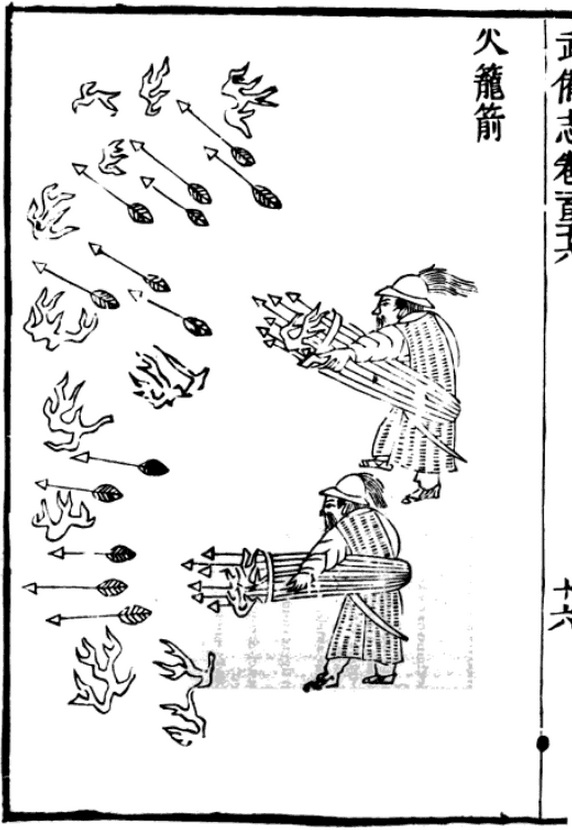
An illustration of fire arrow launchers as depicted in the Wubei Zhi.(wikimedia)
In 1232, a conflict between the Chinese and Mongols escalated. At the battle of Kai-Keng, the Chinese repelled the Mongols using a barrage of fireworks with a strop bamboos. The Chinese called it arrows of flying fire. The fire arrow is a simple solid-propellant rocket. A tube that tapered at one end contained gun powder. The other end is open, and it is attached to a long stick. When ignited, the gun powder rapidly burns and produces fire, smoke, and gas that escaped through the tube's opening. The twig is a simple guidance system that kept the rocket locked in a specific direction when it flies. We don't know how effective these arrows are in destructing, but what we know is the Mongols were psychologically affected. The fire arrow became a formidable tool of war. After the battle of Kai-Keng, the Mongols replicated the fire-arrows, which leads to the spread of rockets in Europe.
There are a lot of rocket experiments between the thirteenth and fifteenth centuries. Roger Bacon found a way to improve the gun powder, which increases the range of rockets. Jean Froissart found out flights in a tube are more accurate. Froissart's discovery leads to the modern bazooka. People used rockets to propel torpedos to set enemy ships alight. In the sixteenth century, rockets are a staple weapon of war.
A firework maker John Schmidlap stumble upon an interesting problem on how he can make a rocket propel at a higher altitude. Rockets need a lot of fuel to fly at a higher altitude, but adding more fuel increases the rocket's mass. He came up with the idea of multi-staged rockets where fuel tanks are dump in stages. The idea became the foundation of modern rocketry.
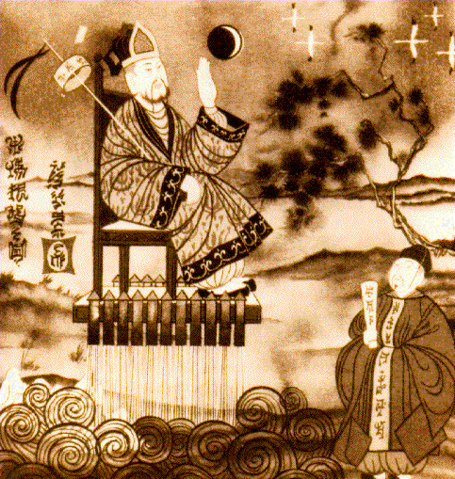
An Illustration courtesy of Marshall Space Flight Center portraying Wan Hu. (wikimedia)
Most of the development of rockets are for warfare or fireworks. Wan Hu came up with the idea of using rockets as transportation. He created a rocket-powered flying chair where he attached the chair to two kites and forty-seven fire arrows at the back for propulsion. He did a public demonstration. Wan Hu sat on the chair, and his assistant lit the fire arrows. The crowd uproared in excitement as a billowing cloud of smoke appears. When the smoke cleared, Wan-Hu and his flying chair obliviate. No one knows what happened to Wan-Hu, but we can guess that he exploded to pieces. Fire arrows were as apt to explode when it takes flight.
Newton's discovery of motion and gravity leads to pushing rocketry to new heights. The law explains how rockets can work and why it is capable of working in space. It became core principles in the practical designs of rocketry. In 1720, Wilem Gravesande built cars that have steam propulsion. Rocket experimenters in Germany and Russia began working with rockets that have greater mass. These rockets exhausted stalwart gas that can burn deep holes in the ground even before lift-off.
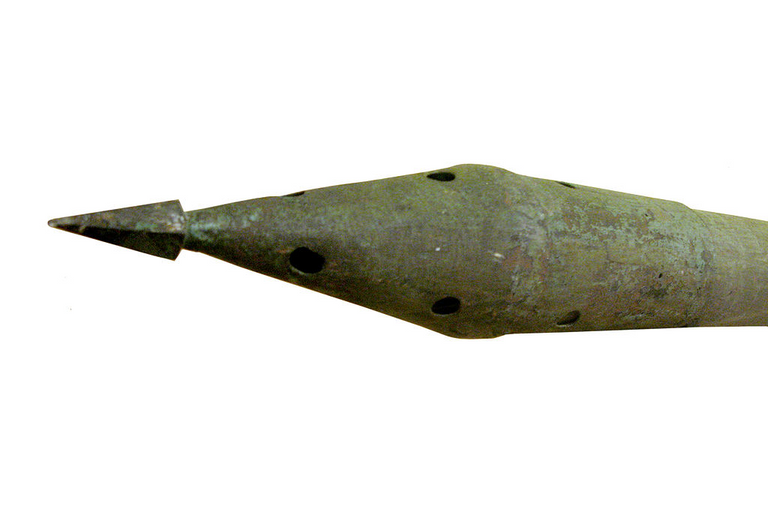
Tip of a Congreve rocket, on display at Paris naval museum. (wikimedia)
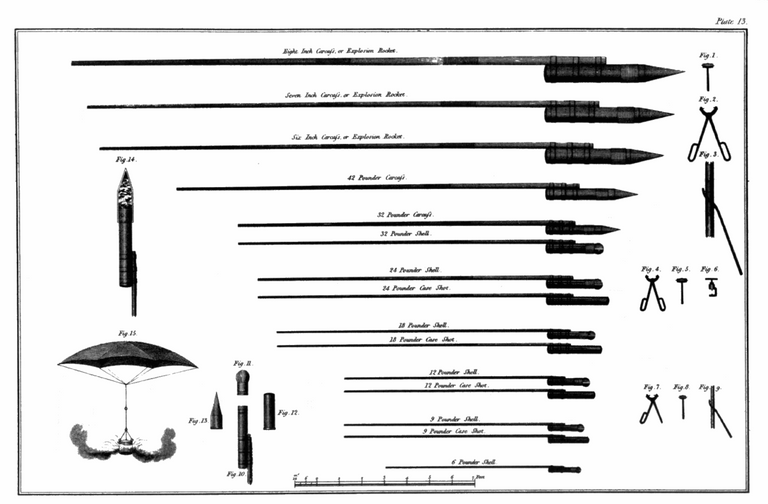
Congreve rockets from Congreve's original work. (wikimedia)
In the eighteenth to the early nineteenth century, rockets became a tool for war once again. Colonel William Congreve heard of the Indian's rocket barrage against the English in 1792 and 1799. He piqued an interest in it. The Congreve rockets are successful when used on the battlefield, but it has accuracy issues. These rockets caused devastating results due to their quantity and not on their power or inaccuracy. At this time, rockets dominate the battles in Europe. In the war of Prussia, the Congreve rockets failed to match the new artillery, which is a breech-loading cannon with rifled barrels.
Modern rocketry began with Konstantin Tsiolkovcky, a Russian school teacher. He envisioned the idea of space exploration in his 1903 paper. He proposed to use liquid fuel for rockets, which revolutionize rocketry. He stated rocket's constraints are its exhaust velocity of the gases. Richard Goddard conducted experiments on rocketry to find new ways in reaching higher altitudes for his rockets. He experimented on a solid-propellant rocket where he measured exhaust velocities. He concluded that rockets propel better with liquid fuels.
Hermann Oberth contributed to the advancement in rocketry in Germany. His book on rocket travel into space gave birth to rocket societies in Germany. The German rocket scientist created a rocket with warheads for their military for world war II. Their extensive research leads to the invention of V-2 rockets, but it came too late to overturn the battle in favor of Germany. It leads to the win of the allied forces.
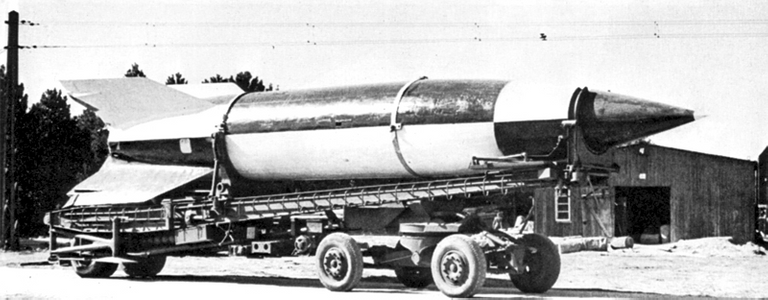
German V-2 rocket (wikimedia)
Nevertheless, by the end of the war, German rocket scientists and engineers laid out plans for advancing the missiles. These missiles are capable of spanning the Atlantic Ocean and landing in the United States. However, these missiles have low payload capacities. After the fall of Germany, the allied forces confiscated several V-2 rockets and their parts. Most German rocket scientists flew to the United States, while some went to the Soviet Union.
Both the United States and the Soviet Union had realized the great potential of rocketry as a military weapon and began a variety of experimental programs. The United States started a program that focuses on high-altitude atmospheric sounding rockets. They contemplate the early ideas proposed by Goddard. After some time, they were able to build medium-range and long-range ballistic missiles.
The Soviets shocked the world when they launched the first orbiting satellite, Sputnik I, in 1957. It is the first successful entry of the great space race. In less than a month, the Soviets then launched another satellite called Sputnik II, which carries a dog, Laika, on board. After the success of the Soviets, the United States hurried to launch their satellite, Explorer I, in 1958. They can't afford to lose to their enemy. In October 1958, they institutionalized NASA.
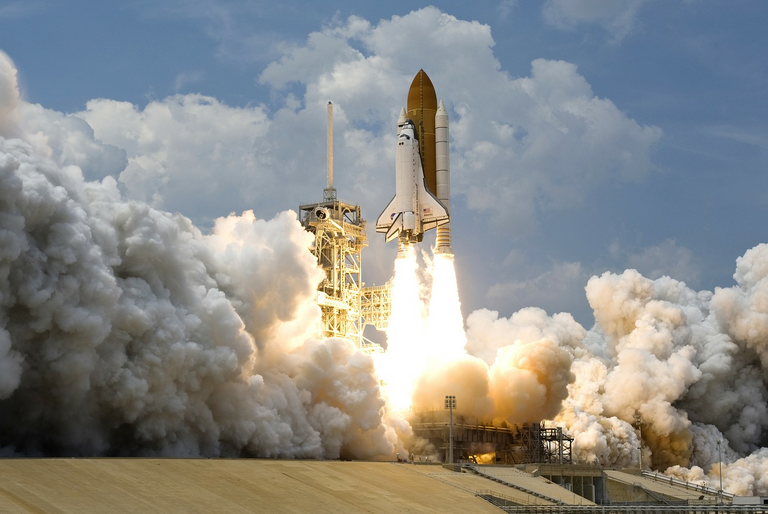
Rocket Launch (pixabay)
During this time, most rockets are multi-staged rockets. It is divided into two or more stages as it launches and takes flight. When the rocket boosters run out of fuel, they detached from the rest of the rocket and dropped away. The first stage then burns to completion and falls off. It leaves a smaller rocket, with the second stage on the bottom, which then fires. This process repeats until it reached the desired final velocity.
Since the earliest days of discovery and experimentation, rockets have evolved from simple fireworks into vehicles that carry humans to space. To date, we have reusable rockets that capable of docking after a mission from space. Rockets have opened the universe to direct exploration by humankind.
References
- The Invention of Gunpowder: A History
- The Evolution of Fireworks
- The History of Early Fireworks and Fire Arrows
- The History of Rocket Science
- Chinese fire-arrows
- Congreve Rocket
- Congreve Rocket Ship-to-Shore Artillery
- The Rocket History
- History’s First Astronaut: The legendary story of Wan Hu
- Wan Hu, The Chinese Astronaut
- Culture Bites: Wan Hu, the Ancient Chinese Rocket Man
- Konstantin Tsiolkovsky and his Role in Rocket Science
- V2: The Nazi rocket that launched the space age
- Hermann Oberth: German Father of Rocketry
- The terrifying German 'Revege Weapon' of the second world war
- Hermann Oberth Publishes "The Rocket into Interplanetary Space"
- Sputnik: The Space Race's Opening Shot
- The Launch of Sputnik, 1957
- Explorer 1: The First U.S. Satellite
- The How and Why of Rockets' Staging
https://twitter.com/juecoree/status/1372145528738222084
Thanks for your contribution to the STEMsocial community. Feel free to join us on discord to get to know the rest of us!
Please consider supporting our funding proposal, approving our witness (@stem.witness) or delegating to the @stemsocial account (for some ROI).
Please consider using the STEMsocial app app and including @stemsocial as a beneficiary to get a stronger support.
Points Boosting refund to @juecoree! 🤓
Due to one of these reasons:
1. Post is not published via Ecency.
2. Post is already curated by our team.
3. Post is not curated by our curators within 24 hours.
4. Post might be too old post, try more recent content.
5. Author already received vote in last few hours, try again later.
Install Android: https://android.ecency.com, iOS: https://ios.ecency.com mobile app or desktop app for Windows, Mac, Linux: https://desktop.ecency.com
Learn more: https://ecency.com
Join our discord: https://discord.me/ecency